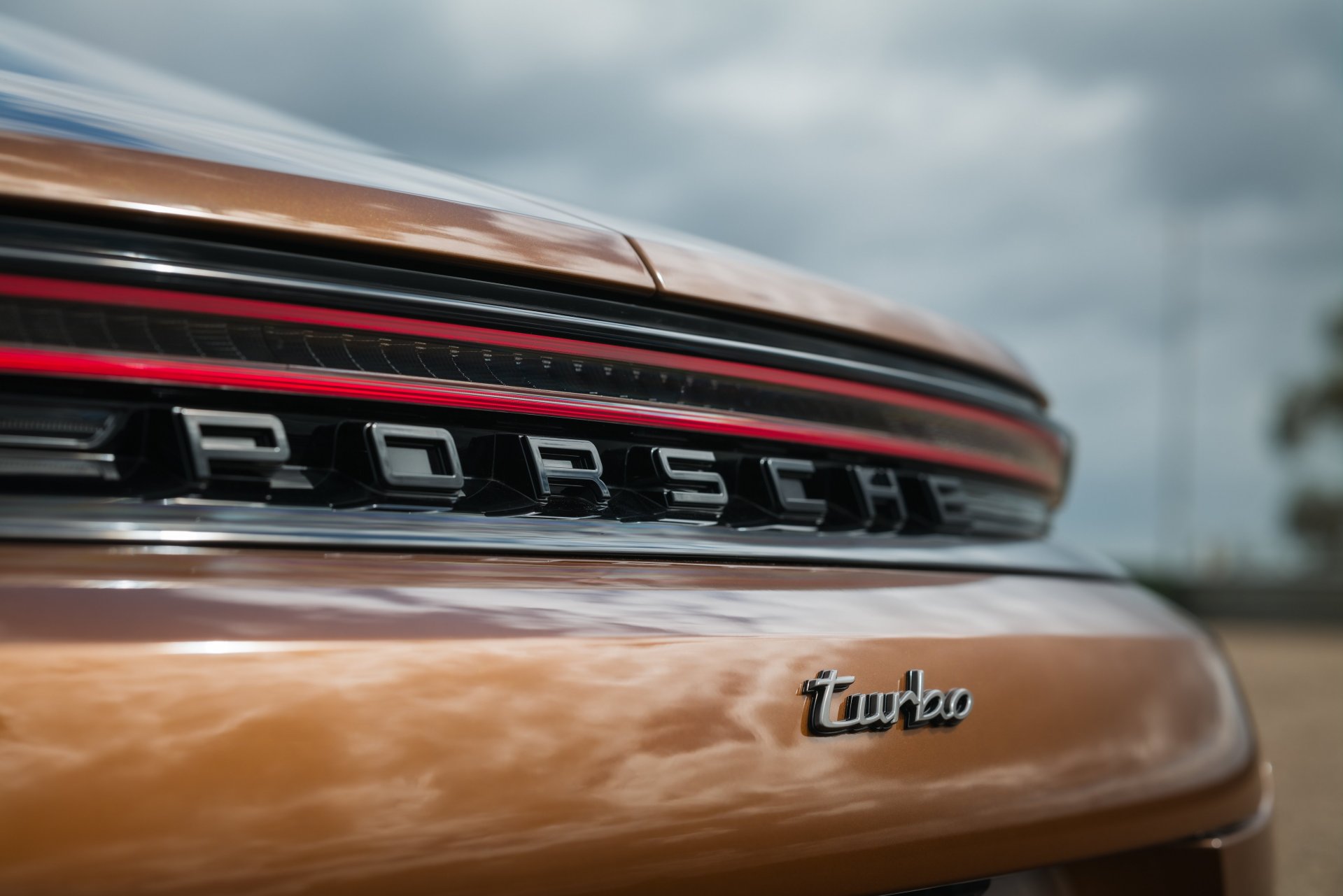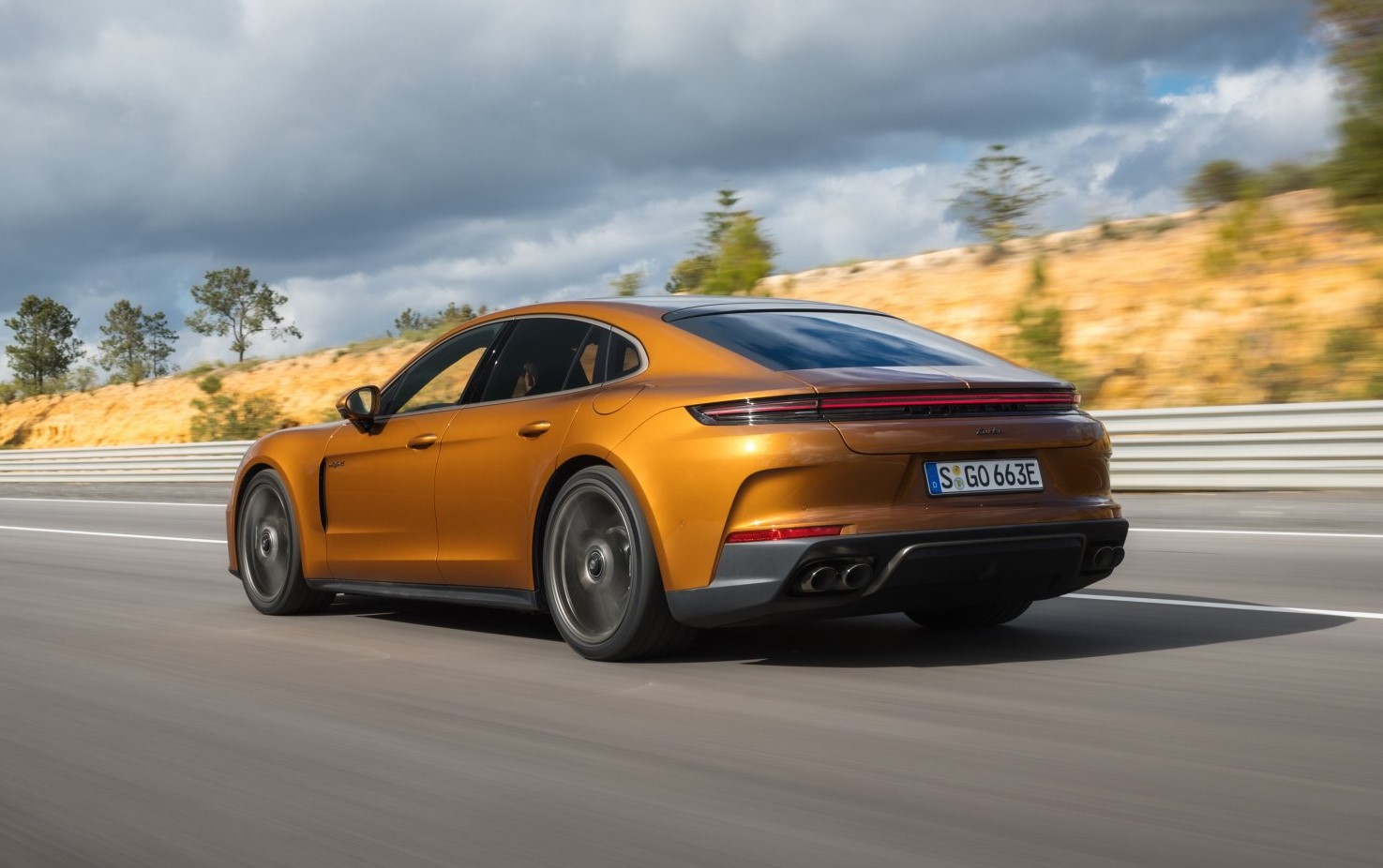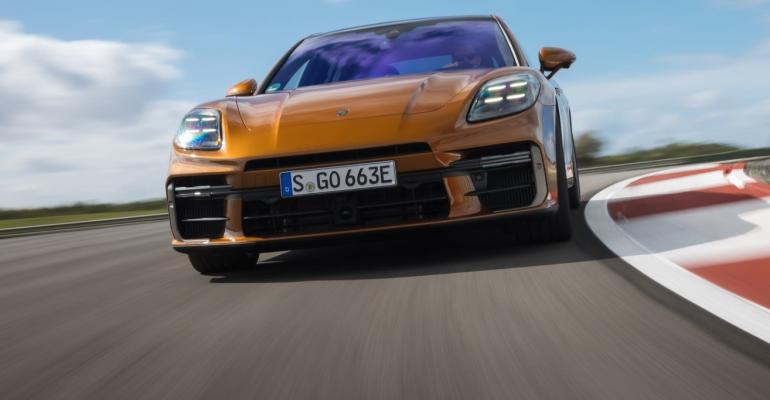SEVILLE, Spain –Turn one of the 2.7-mile (4.35 km) -long Monteblanco circuit near here is a tricky right-hander. With two apexes and a slight change in camber on the exit, it is a corner that challenges even the most dynamically adept of road cars, not to mention their drivers.
Not today, though. On our third lap in the ’24 Panamera Turbo E-Hybrid, we run to the end of the main straight and continue to scythe through the turn at great pace, the body of the big Porsche remaining incredibly flat.
Despite the high cornering speed, the new 671-hp gasoline-electric-powered sedan feels marvelously secure and well within its limits. There’s no unruly body lean or pitch as we get back on the power after a confidence-settling dab on the brakes, just tremendously calm qualities that help to ensure grip and traction remain high.
This is our first chance to sample just how effective the ’24 Panamera and its new Porsche Active Ride suspension is. The answer? Mind-blowing.
Even Porsche, with all its engineering expertise, admits it didn’t quite anticipate just how radically its latest suspension development would alter the dynamic properties of the third-generation model.

Set for North American delivery next month at a starting price of $101,550, the Panamera is the first model from the German automaker to feature the advanced system. Available as an option exclusively on plug-in hybrid versions of the sedan for the time being, it also will be made available on the facelifted Taycan and other new electrified Porsche models in the not-too-distant future.
Porsche Active Ride is not the first active suspension to be offered on a series-production road car, but it is arguably the most advanced, offering reactive instead of adaptive qualities and allowing engineers to ditch the anti-roll bars completely for added weight savings.
It builds force within an electro-hydraulic system to counter body movements, keeping the sedan level at all times and enabling it to carry significantly more speed through corners than Panamera models fitted with the standard air suspension – itself modified with new 2-chamber air springs in place of the 3-chamber units used on the second-generation model.
To do this, the damping characteristics are controlled by electro-hydraulic pumps front and rear. Mounted together where the traditional roll bars reside in other Panamera models, they continuously vary the amount of hydraulic pressure at each corner. The wheels move independently of one another, with up to 2,248 lbs. (1,020 kg) of force available to act on each shock absorber to keep the body level.
The pumps draw electricity from the same 400V battery used by the Panamera’s newly developed plug-in hybrid drivetrains. They operate at 13 hertz, so they’re able to alter the damping characteristics up to 13 times a second. Information is collected by inertia sensors and accelerometers used to monitor roll, pitch, dive, yaw and other body motions, with reactions calculated by a central processing unit.
Out on the track, the advantages of Porsche Active Ride immediately become apparent. Compared to the standard air suspension of new Panamera models, it resolutely keeps the body flat even at high G-forces. Importantly, it works in a way that makes the handling fluid and communicative. You’re an integral part of the action, not a mere passenger.
When a wheel hits a curb out on the circuit, the shock is soaked up instantly. And because they act independently of one another, you don’t get a reaction at the opposite wheel, as with the Panamera’s standard air suspension.
In the Sport Plus driving mode, the new system even leans the new Porsche into corners, mimicking the action of a motorcycle. This results in a lower roll center height and a more even distribution of load at each wheel, for even faster cornering speeds. There’s better grip, too, as the inside wheel accepts greater load and the outer wheel is relieved, making for more neutral handling qualities.
In the new Panamera, Porsche Active Ride is combined with single-chamber air springs. However, they are only used to support the body when it is switched off. The electro-hydraulic pumps support it while it is running, but they require too much energy when it is parked to go without a backup. A parking function sees the air springs extend ride height 2.1 ins. (53 mm) to ease entry and exit.
The third-generation Panamera lineup begins with the rear-wheel-drive Panamera and all-wheel drive Panamera 4, both with an updated version of the twin-turbocharged 2.9L V-6 used by their predecessors, boasting an added 23 hp and 37 lb.-ft. (50 Nm) of torque at 348 hp and 369 lb.-ft. (500 Nm).

Further up are the rear-wheel-drive Panamera E-Hybrid and all-wheel-drive Panamera 4S E-Hybrid. They combine the same gasoline V-6 with a new 188-hp electric motor mounted within the Porsche model’s standard 8-speed dual-clutch gearbox and 25.9-kWh lithium-ion battery, developing a combined 536 hp and 553-lb ft. (750 Nm).
Topping the initial lineup is the all-wheel drive replacement for the old Panamera Turbo S E-Hybrid. Now badged simply as the Panamera Turbo, it receives the same electric components as the Panamera 4 E-Hybrid and Panamera 4S E-Hybrid, but in combination with a heavily upgraded twin-turbocharged 4.0L gasoline V-8.
It exchanges the previous twin-scroll turbochargers for single-scroll units that are claimed to draw less heat from the exhaust system, allowing the catalysts to heat up faster. Combined power actually drops by 19 hp over the old Panamera Turbo S E-Hybrid to 671 hp, with torque up 44 lb.-ft. (60 Nm) to 686 lb.-ft. (930 Nm) The electric range, meanwhile, is put at 57 miles (92 km) on the combined WLTP test cycle.
Other models are planned, including a replacement for the Panamera GTS, though for the time being Porsche has unveiled these five.
Even in base rear-wheel-drive Panamera form, it is highly competent, delivering a 0-62 mph (100 km/h) time of 4.8 seconds and responsive steering feel. This is further enhanced with the addition of all-wheel drive in the Panamera 4S, which brings greater traction and grip.
The adoption of air springs even on the base model brings a big improvement in ride quality and better isolation of road shock compared to the old model. You do notice quite a lot of tire roar on less-than-smooth surfaces, though.
The Panamera Turbo E-Hybrid delivers a significant lift in performance, with a 0-62 mph time of 3.2 seconds. We didn’t get to drive it on the road, but on the track the optional active suspension clearly makes a huge difference, elevating the already impressive dynamic properties to a new level.

There is very little lean at any time. It’s more telling to witness the effect of the new electro-hydraulic underpinnings from outside the car, its wheels moving markedly within the wheelhouses while the body remains level.
It’s not only the handling that benefits. Ride comfort is also fundamentally transformed, delivering the sort of cosseting qualities you’d expect from a true limousine in the appropriate driving mode. On top of this, the Porsche boasts outstanding mechanical refinement, making it a great long-distance tourer.
The Panamera remains the vehicle of choice for those seeking a luxury sedan with a truly sporting touch. The third-generation model represents a huge advancement over its predecessor. Prices range from $101,550 for the rear-wheel-drive Panamera to $128,795 for the Panamera 4S E-Hybrid, with Porsche yet to confirm a U.S. price for the Turbo E-Hybrid.





